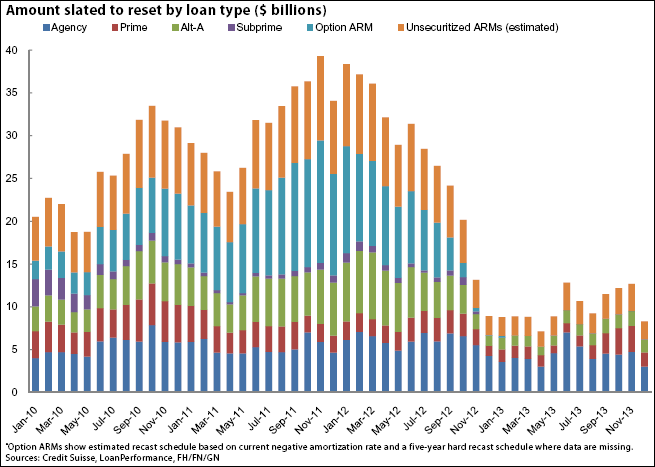While several industry observers worry about  negative equity and
negative equity and  unemployment driving foreclosures, a couple of experts point out that interest rates on mortgages remain a cause for concern.
unemployment driving foreclosures, a couple of experts point out that interest rates on mortgages remain a cause for concern.
Credit Suisse made waves in 2007 among housing bears with a chart that estimates the volume of adjustable-rate mortgages to face a reset each month. An updated version of the chart, which was provided to SNL, shows resets remain a worrying force over the next few years.
Most of the resets are expected to occur through 2012. Between 2010 and 2012, the chart indicates that $253.25 billion of option ARMs will adjust, while Alt-A loans totaling $163.71 billion will reset over that time. Altogether, $1.010 trillion worth of ARMs will reset or recast during the three-year period.

"Option ARM resets are still pending. … Nothing much has happened yet because rates were so low that resets were pushed back," Chandrajit Bhattacharya, head of non-agency RMBS and ABS strategy at Credit Suisse, told SNL.
Though option ARMs have  grabbed some headlines recently, they are not the primary concern for analysts such as Bhattacharya and Greg McBride, senior financial analyst at Bankrate.com. McBride told SNL he is more concerned about ARMs that do not even show up on Credit Suisse's chart.
grabbed some headlines recently, they are not the primary concern for analysts such as Bhattacharya and Greg McBride, senior financial analyst at Bankrate.com. McBride told SNL he is more concerned about ARMs that do not even show up on Credit Suisse's chart.
Borrowers who already have seen their ARMs reset might be sitting on their hands and not refinancing into fixed-rate products, McBride said. Because mortgage rates have been so low recently, resets can actually lower, not raise, monthly payments. When that happens, borrowers might feel little urge to refinance into a fixed-rate product that would cost more per month. Alternatively, ARM borrowers might simply struggle to qualify for a refinance because of low or negative equity.
The problem, McBride said, is that when interest rates increase — which many analysts  expect to happen over the next year — borrowers' monthly payments might increase beyond what is affordable for them. And at that point, the fixed-rate products will no longer be attractive, or even financially viable, options.
expect to happen over the next year — borrowers' monthly payments might increase beyond what is affordable for them. And at that point, the fixed-rate products will no longer be attractive, or even financially viable, options.
McBride said the government's Home Affordable Refinance Program could help many of those homeowners avoid such payment shocks. But the program does not appear to be gaining much traction.
"The avoidable scenario is interest rates start to go up over the next couple of years, and all of a sudden, millions of homeowners who are stuck in adjustable rate mortgages and haven't been able to refinance out of them become sitting ducks for big payment increases," McBride said. "And then here we go again. It's like 2007 all over again. And again, the HARP program is key to avoiding that iceberg, and we're headed right for that iceberg, and no one's turning the wheel because everyone's focused on mortgage modifications."
Yet Bhattacharya said the ARM reset chart does not portend the all-out doom some housing bears infer. For one, option ARMs are concentrated in just a few states. A Fitch Ratings study from Sept. 8, 2009,  reported that three-quarters of all option ARMs were in California, Florida, Nevada and Arizona.
reported that three-quarters of all option ARMs were in California, Florida, Nevada and Arizona.
Likewise, McBride was cool to the idea that option ARMs could flood the foreclosure rolls. Option ARMs are less concerning, he said, because so many have defaulted already. Indeed, the September 2009 Fitch Ratings report showed that 30-day delinquencies on option ARMs sat at 46% even though just 12% had recast. Further, option ARM foreclosure rates  already match the sky-high subprime foreclosure rates.
already match the sky-high subprime foreclosure rates.
Instead, McBride is worried about the prime ARMs posted in the Credit Suisse chart. The chart shows $10 billion to $15 billion resetting each month. If a substantial number of those borrowers do not refinance and interest rates shoot up, McBride said he could see $50 billion worth of prime ARMs facing payment shocks each month by 2011.
To be sure, the economy and the large number of delinquent mortgages yet to enter the foreclosure pipeline remain larger concerns than ARMs, both Bhattacharya and McBride said.
"If you look at it, there's almost probably 5 million borrowers sitting there in some sort of delinquency right now who have yet to be foreclosed upon. So if you say [the Home Affordable Modification Program] is going to save only a small fraction of that, the rest of them have to go through in some form of foreclosure or distressed sale," Bhattacharya said. "So it's definitely not over by any means."
Credit Suisse projects 10 million foreclosures over a five-year period starting in 2008.
Cristian de Ritis, a director at Moody's Economy.com, agreed with Bhattacharya's balancing between interest rates and the economy, in large part because de Ritis sees interest rates increasing incrementally.
"That should give a signal to some of the hold-outs of ARMs to refinance while they still have the opportunity," de Ritis told SNL. "So I would say it's something to watch for, but it's not the primary concern at this point. We're still mostly concerned about unemployment being the burden."


